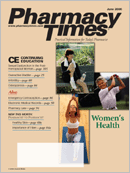Publication
Article
Pharmacy Times
On-line Health Care: Identifying Quality Information
More than 100 million Americans, or 8 of 10 users of the Internet, regularly search for health-related information there.1,2 With >100,000 sites offering medical information, a nebulous search term such as "cancer" will return >500 million links.2 Despite the volume, users find material fairly proficiently, with an average search time of 5 minutes 42 seconds.3
Some consumers judge a site's credibility by looking for a professional logo. Others just use the first few links listed by the search engine. Surprisingly, one study found that participants never reviewed Web pages' "About Us" sections.3
The level of misinformation is alarming, as are sites promoting fraudulent products that claim to cure incurable diseases such as AIDS or sites proposing dubious theories of disease pathogenesis. Sometimes, this snake oil is not just colored water?it is dangerous. Several red flags (Table 14) should send Internet users scurrying.
Evaluating Sites
As the Internet grows in popularity, so does the need for rating information quality. Five approaches rate site credibility, but none is universally endorsed:
1. Codes of conduct: This approach applies criteria promulgated by major professional groups and organizations (eg, the American Medical Association) for Web site content.
2. Quality labels: A third-party provider ensures that a Web site complies with recommended criteria and ethics.
3. Filtering tools: Search tools accept or reject entire sites based on preset criteria (eg, they accept only online journal articles or those from professional associations).
4. User guides: Consumers judge sites based on the sites' compliance with recommended guidelines.
5. Third-party certification: A third party grants time-limited certification and accreditation.2
Most popular, the quality label Health On the Net's (HON) logo graces >3000 sites, signifying conformity with HON's 8 principles.2,5 An example of one of HON's guiding principles is attribution. That principle states, "Where appropriate, information contained on this site will be supported by clear references to source data and, where possible, have specific HTML links to [those] data."5
The Utilization Review Accreditation Program is an increasingly popular independent third-party certifying organization. Users can access URAC's accredited Web sites at http://www.urac.org. URAC's accreditation is voluntary and requires a fee. Consequently some very good sites are missed if users limit searches to URAC-certified sites. WebMD, for example, is listed, but the highly reputable Medscape is not.
For Researchers and Professionals
The Internet has facilitated access to professional journals dramatically: ~75% are available on-line. Once accepted for publication, many articles are available on-line prior to publication. Advance posting comprises 10% of all articles indexed by PubMed, the on-line search service of the National Library of Medicine.1
Along with automated drug references, such as Facts and Comparisons, and professional associations' Web sites, several other Web sites deserve pharmacists' attention:
- The National Library of Medicine (http://www.nlm.nih.gov) is arguably the country's best medical library, with >4500 holdings
- Stanford University's HighWire Press (http://highwire.stanford.edu) hosts 919 scholarly journals with a large archive of full-text articles
- Fedstats (http://www.fedstats.gov) links users to statistics on many topics
- The Agency for Healthcare Research and Quality (http://www.ahrq.gov) provides evidence-based treatment guidelines
- The National Organization for Rare Disorders (http://www.rarediseases. org) provides information on rare diseases, their incidence, and treatment
- Medscape (http://www.medscape.com), a multidisciplinary site for health care practitioners, has extensive pharmacy materials
For Patients
Many of the above sites also contain sections geared to the general public. The Medical Library Association's (MLA) guide for finding and evaluating information (http://www.mlanet.org/resources/userguide.html) tackles credibility issues. The MLA also lists its "Top Ten" consumer health Web sites, which meet ethical and content guidelines, and pharmacists can confidently recommend these sites (Table 2).6 Table 3 presents a sampling of MLA's recommended disease-specific sites.
Search Engines
Although Google is America's favorite search engine, neither it nor any other search engine identifies relevant information perfectly, because each employs different search criteria. Desiring a comprehensive search, many users turn to meta-search engines that employ several engines simultaneously. One is Dogpile.com (www.dogpile.com), which returns hits found by Google, Search, Yahoo!, MSN Search, and Ask (formerly Ask Jeeves). Selecting search criteria carefully is essential when using metasearch engines, or the result will be voluminous, with many irrelevant sites.
Launched in 2004, Google Scholar (http://scholar.google.com) searches only scholarly literature, including theses, books, and reprints from scholarly organizations. Google Scholar is growing in popularity because it locates material that PubMed does not.
Rumor Control
To address broadcast e-mails or urban health myths warning of imminent health threats, the Centers for Disease Control and Prevention maintains a Web site exposing health-related hoaxes and rumors (http://www.cdc.gov/doc.do/id/ 0900f3ec80226b9c). One hoax listed, for example, is the statement that antiperspirants cause breast cancer.
Final Thought
Adopting a code of ethics or adhering to a set of guidelines for posting Internet health-related information is currently voluntary. Certification programs, comparable to organizations accrediting continuing education credits, may be the solution, and this initiative is gaining momentum. Until then, "user beware" remains the guiding principle.
Ms. Wick is a senior clinical research pharmacist at the National Cancer Institute, National Institutes of Health, Bethesda, Md. Dr. Zanni is a health-systems consultant and a psychologist based in Alexandria,Va.Views expressed in this article are those of the authors and not those of any government agency.
For a list of references, send a stamped, self-addressed envelope to: References Department, Attn. A. Stahl, Pharmacy Times, 241 Forsgate Drive, Jamesburg, NJ 08831; or send an e-mail request to: [email protected].

Newsletter
Stay informed on drug updates, treatment guidelines, and pharmacy practice trends—subscribe to Pharmacy Times for weekly clinical insights.






